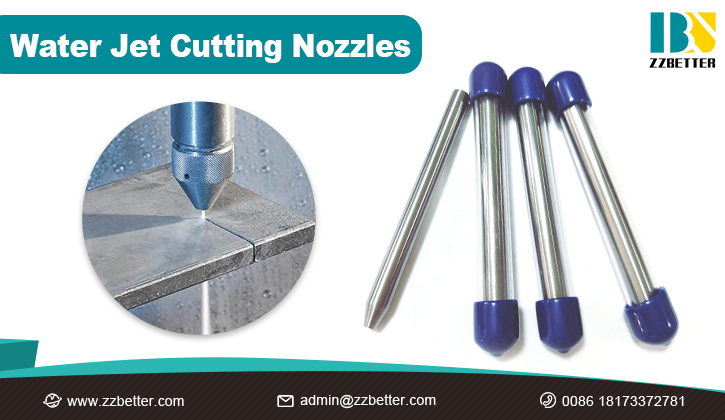How Does Waterjet Cutting Work?
How Does Waterjet Cutting Work?

As waterjet cutting is a cutting method, which is extensively used in many industries, such as aerospace, automotive, electronics, medical, architectural, design, food manufacturing, and so on. This article is going to tell you how waterjet cutting work following the order:
1. Brief introduction of waterjet cutting;
2. Waterjet cutting machines;
3. Waterjet cutting materials;
4. Waterjet cutting principle;
5. Waterjet cutting process.
Brief introduction of waterjet cutting
Waterjet cutting is a practical cutting method to cut metals, glass, fiber, food, and the like. Usually, waterjet cutting is to form a high-pressure and thin water stream to cut the materials, leaving no-carve and burns. This process is a function of pressure, speed, abrasive flow rate, and nozzle size. Waterjet cutting eliminates the need for secondary finishing, saving significant time and improving efficiency. There are two main types of waterjet cutting: pure waterjet cutting with only water and abrasive waterjet cutting where abrasive is added to the waterjet. Pure water cutting is used for softer materials such plywood, gaskets, foam, food, paper, carpet, plastic, or rubber as there the waterjet has enough energy to pierce and cut the material. Adding abrasive and thus creating a mixture of abrasive and water is increasing the energy of the jet and this can be used to cut hard materials such as metals, ceramic, wood, stone, glass, or carbon fiber. Both methods can be referred to as waterjet cutting.
Waterjet cutting machines
During waterjet cutting, a waterjet cutting machine is needed. A waterjet cutting machine, also known as a water jet cutter or water jet, is an industrial cutting tool capable of cutting a wide variety of materials practically in any form. It is a non-thermal cutting method that is based on a high velocity of a waterjet. It enables extremely fine, precise cuts on sensitive, hard and soft materials as well as on non-metals such as ceramics, plastics, composites, and foods. By this machine, water is pressured into extremely high pressure and this jet is focused on the material that needs to be cut. With the power of erosion, the jet will go through the material separating the pieces. When mixed with fine abrasive sand, a waterjet cutting system also cuts enormous material thicknesses without changing the material structure in the cutting area.
Waterjet cutting materials
Waterjet cutting can be applied to cut several materials, including metals, wood, rubber, ceramics, glass, stone and tiles, food, composites, paper, and the like. The high velocity and pressures generated by the waterjet cutting system can make them cut thin and thick metals, like aluminum foil, steel, copper, and brass. One of the biggest advantages of waterjet cutting is the non-thermal cutting method, meaning that the material will not be affected by the heat leaving the surface without burn marks or deformation.
Waterjet cutting principle
The main principle of this equipment is the direction of a water stream at high pressure to the cutting head, which supplies flow onto the working material through a small hole, waterjet cutting nozzle. It all starts with ordinary tap water. It is filtered and pressurized in a high-pressure pump, then delivered via high-pressure tubes to the water jet cutting head. A small diameter orifice will concentrate the water beam and the pressure turns into velocity. The supersonic water beam cuts all kinds of soft materials like plastic, foam, rubber, and wood. This process is called the pure waterjet cutting process.
To increase the cutting power, grains of an abrasive are added to the stream and the water beam turns into high-speed liquid sandpaper cutting all kinds of hard materials like stone, glass, metal, and composites. This process is called abrasive waterjet cutting.
The former method is used for shaping softer materials and the latter one is intended for solid sheet materials.
Waterjet cutting process
The first step is to pressurize the water. The cutting head is the next destination of highly pressurized water. A high-pressure tubing is used to make the water travel. When the pressurized water reaches the cutting head, it goes through a hole.
The orifice is very narrow and smaller than a pinhole. Now use the fundamental law of physics. The pressure converts into velocity when that travels through the tiny hole. The intensifier pump could produce pressurized water at 90 thousand psi. And when that water passes through the tiny hole of the CNC machine, it can generate a velocity of nearly 2500 miles per hour!
A Mixing chamber and nozzle are two components of the cutting head. In most standard machines, they are set directly below the water ejection hole. The purpose of this mixing chamber is to mix the abrasive media with the steam of water.
Water accelerates the abrasive in the mixing tube located below the mixing chamber. As a result, we get powerful steam that can cut nearly any type of material.

If you are interested in tungsten carbide waterjet cutting nozzles and want more information and details, you can CONTACT US by phone or mail at the left, or SEND US MAIL at the bottom of the page.





















